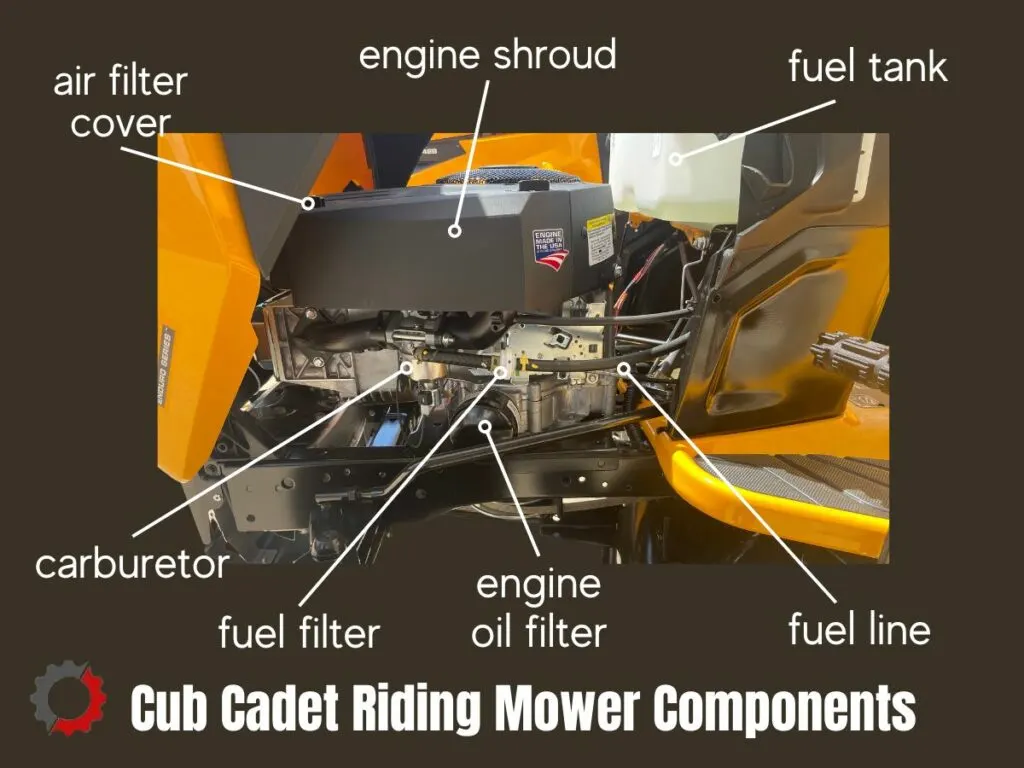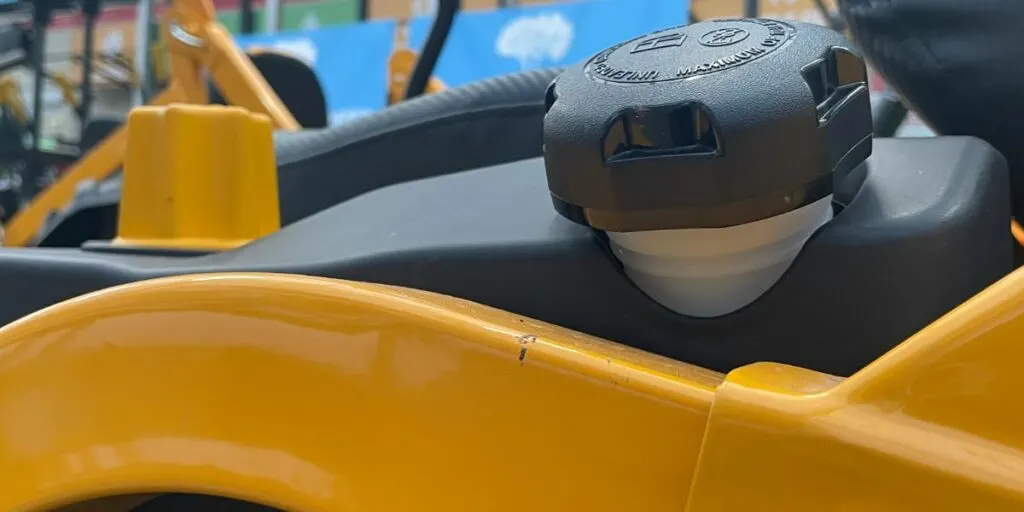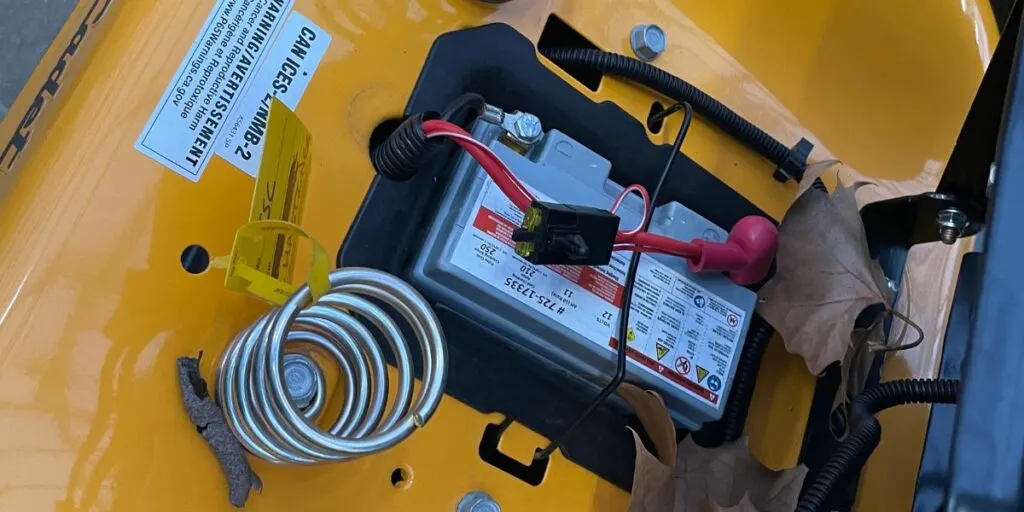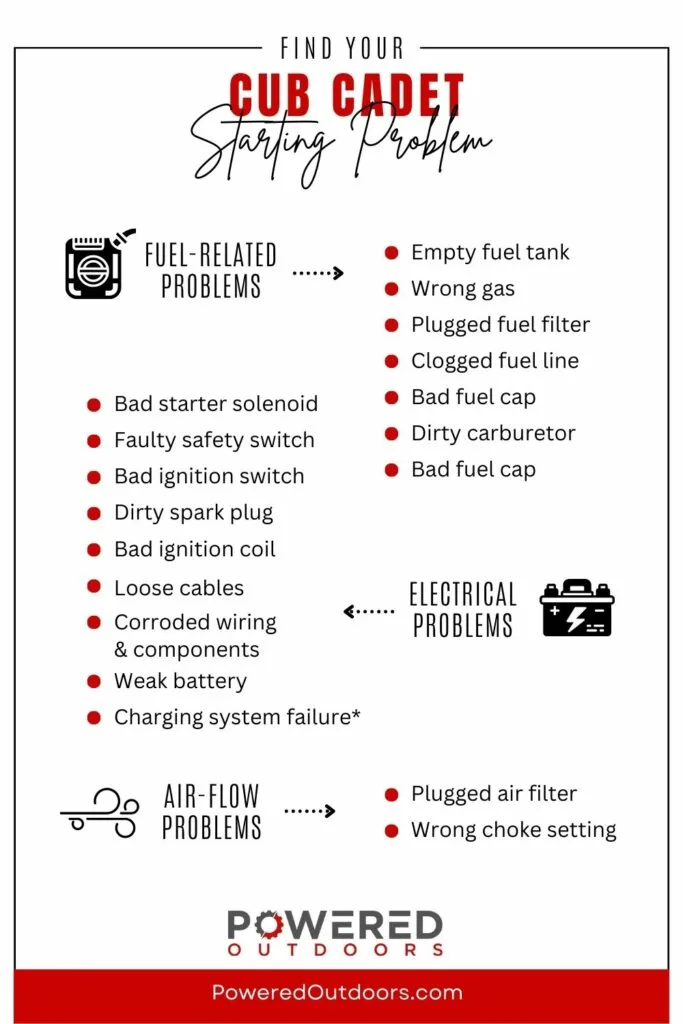A Cub Cadet lawn mower won’t start when the engine isn’t getting good air, fuel, compression, and spark due to a bad air filter, dirty carburetor, bad spark plug, weak battery, faulty starter solenoid, and more.
The article addresses lawn tractors, riding mowers, and zero-turns. So, whether you are working on an XT1, XT2, SLT1550, Ultima XT, or another model, this guide is sure to help you. While many of the same issues will happen to a zero-turn, you will find an article for zero-turn mowers here.
I start with troubleshooting tips and follow up with listing the items that can cause a starting problem.

More guides on Cub Cadet starting problems:
- Cub Cadet clicks but doesn’t start
- Cub Cadet zero turn or lawn tractor won’t turn over or crank
- How do you know your Cub Cadet starter solenoid is bad
Follow all safety instructions provided in your equipment operator’s manual before diagnosing, repairing, or operating. Consult a professional if you don’t have the skills, or knowledge or are not in the condition to perform the repair safely.

START HERE: Troubleshoot Cub Cadet Mower Starting Problems
A Cub Cadet internal combustion engine won’t work when air and fuel are not drawn into the cylinder, compressed, and ignited with a spark.
Begin looking for a starting issue by checking fuel flow, airflow, and spark.
Step 1: Check for a Fuel Problem
Old gas is often the root cause for fuel components to stop functioning or for clogs to develop.
Before checking for a fuel problem, if your mower has a fuel shut-off valve, make sure it is in the open position. This valve is often moved to the closed position when the mower is stored or for transportation.
Perform this test to narrow down your problem to the fuel system:
- Detach the air filter cover and remove the air filter.
- Spray carburetor cleaner into the air intake. Find out why I use carburetor cleaner and not starter fluid.
- Attempt to start your mower using the manual pull rope or turning the ignition key (depending on your mower type)
- If the mower attempts to start or starts, then you have a problem with the fuel system.
- The most common fuel issues are a dirty carburetor, a clogged fuel filter, and clogged fuel lines. The fuel pump may also be an issue if your mower uses one.
- If the mower doesn’t attempt to start, you most likely have a spark plug problem.
- If the mower attempts to start or starts, then you have a problem with the fuel system.
Check for an Airflow Problem
Air is an important component needed for your engine to start. The engine must run rich to start a cold engine. This condition allows more fuel and less air into the cylinder.
Airflow is controlled by the choke. You will find a choke lever that opens the choke plate to introduce more air and close the choke plate to restrict air.
On newer push mowers, you will find an automatic choke controlled by a thermostat.
Perform this test to narrow down your problem to the air supply system:
- Detach the air filter cover and remove the air filter.
- Inspect the air filter’s condition. A clogged air filter will restrict airflow. Clean the filter or replace it if it is very dirty or damaged.
- With the air filter removed, inspect the choke plate.
- Manual-choke model
- Move the choke lever to the on position: The choke plate should be closed.
- Move the choke lever to the off position (on some models, this is placing the throttle in the fast throttle position): The choke plate should be open.
- Auto-choke model
- The choke plate should be closed when the engine is cold and moved to the open position when the engine warms. This type of system is found on many Cub Cadet push mower models.
- Manual-choke model
- If the choke isn’t opening and closing correction, check the choke linkage and choke cable. Loosen a stuck choke by lubricating the linkages and choke shaft using carburetor cleaner. Replace a bad choke cable (if used on your model).
Check for a Spark Problem
Spark must be released at the right time for combustion. A spark plug may fail to spark if it is dirty or damaged. It may also fail due to a loose spark plug wire, a bad ignition coil (armature), or other ignition system problems.
Perform this test to narrow down your spark problem:
- Remove the spark plug wire (boot) from the spark plug.
- Attach a spark plug tester to the spark plug ignition wire.
- With the spark plug still installed, attach the other end of the spark plug tester to the spark plug.
- Attempt to start the engine using the pull cord or electric start.
- You will see a glow in the transparent section of the tester if it is generating a spark.
- If you don’t see a glow, the spark plug may be bad or you may have a bad ignition coil. On electric start models, you may have a problem with the ignition system including the battery, wiring, and starter solenoid.
18 Reasons Your Cub Cadet Mower Isn’t Starting
1. Empty Fuel Tank
When the fuel tank is empty, you will not be able to power the engine.
SOLUTION: Fill the gas tank with fresh fuel.
- Inspect the fuel system and repair any leaks.
- Make sure the fuel gauge is working (if used on your model).
- Add gas with a minimum 87 octane rating and no more than 10% ethanol content.
You can also read about the effects of ethanol on a Cub Cadet small engine here.
2. Bad or Old Gas
Gas becomes old and begins to deteriorate and become less effective as quickly as 30 days after purchase. This old fuel may lose its volatility and no longer combust.
Ethanol, an alternative fuel added to most gas, naturally attracts moisture to the fuel system. This leaves behind varnish and gummy residue that clogs the fuel passageways including the fuel lines, filter, and carburetor.
You can tell the gas is bad if it has a strong foul odor or if the fuel has turned yellowish in color.
Avoid the effects of old fuel in your mower using these tips:
- Purchase fresh gas for your Cub Cadet with a minimum 87 octane rating and a minimum of 10% ethanol content.
- Consume fuel within 30 days.
- Use a fuel additive to make gas stable so it last longer before it breaks down. Read more about fuel additives here.
- Store fuel in a dry location away from moisture.
SOLUTION: Remove the old fuel from the fuel tank and refill it with fresh fuel and a fuel additive to clean the fuel system.
- Wipe around the fuel cap to remove loose dirt and debris. Remove the cap.
- Using a fuel siphon pump or another method, drain fuel into an approved fuel container.
- Add a fuel additive like Sea Foam Motor Treatment to your container of fresh gas. This is to help clean the fuel system, remove moisture, and keep the gas stable longer.
- If you are able to start the mower, start and allow the mower to run so the treated fuel mixture works its way through the fuel system.
- If it doesn’t start, keep troubleshooting with the items below. Let the mower run for a while once you are able to start it.

3. Bad Fuel Cap
A bad fuel cap can keep the engine from starting. The fuel tank must have a vent allowing air to enter the fuel tank as fuel is consumed.
This vent is built into the fuel cap on your Cub Cadet. A vacuum forms inside the tank preventing fuel from flowing to the carburetor when the vent is clogged.
SOLUTION: If your Cub Cadet stopped running and won’t restart, determine whether you have a vacuum problem using a pressure gauge or follow these simple steps if you don’t have a gauge:
- Wipe around the fuel cap to remove loose dirt and debris.
- Loosen the fuel cap to allow air to enter the fuel tank.
- Attempt to start your mower.
- If it doesn’t start, tighten the fuel cap and continue to troubleshoot other items that may cause your starting issue.
- If it starts, tighten the fuel cap and allow your mower to continue to run. You’re trying to replicate the issue where your mower begins to run sluggish and dies due to a vacuum problem.
- If your mower started once you loosened the cap, but died after you tightened it and allowed it to run for a while, there’s a good chance the cap is no longer venting.
Replace a gas cap that is no longer venting with a new fuel cap.
4. Fouled or Loose Spark Plug: Bad Connection
A bad spark plug connection or damaged spark plugs can prevent the plug from providing a spark to ignite the fuel and air mixture.
A fouled spark plug that has carbon buildup or oil on the tip can cause your engine to misfire and not start.
SOLUTION: Replace a very dirty or damaged spark plug. You may have two spark plugs on your engine model if you have a twin-cylinder engine.
- Remove the spark plug wire (boot).
- Wipe around the spark plug to remove loose dirt.
- Use a spark plug socket wrench to remove the plug. Depending on your engine model, you’ll need a 3/4″ or 5/8″ socket.
- Inspect the plug for damage, wearing, or a dark tip from carbon buildup. If you find these conditions, it’s best to replace the spark plug with a new one.
- You can also clean it with a wire brush if it’s lightly dirty and in good condition.
- Check the spark plug gap to ensure it is at the engine manufacturer’s specifications.
- Install the good spark plug.
- Attach the spark plug wire. Make sure you remove the wire(s) if you are making more repairs.
I choose to replace the spark plugs when they are dirty or may inhibit the performance I receive from my mower. It’s an inexpensive maintenance item that will cause issues if it’s not in good working condition.
Spark plug(s) should be replaced annually.
5. Clogged Engine Air Filter
A dirty air filter won’t allow sufficient air to pass through the filter and into the air intake. It can starve the engine of air because sufficient air will no longer be able to pass through the filter.
The engine must find air to continue to run when the airflow is blocked by your air filter. It may overheat and draw what air it can find from the crankcase which can cause extensive damage to the engine.
The air filter is a maintenance item that should be replaced annually and cleaned several times throughout the mowing season.
SOLUTION: Inspect and replace an air filter that is very dirty or damaged. Clean a filter if it is lightly dirty using the steps below for a couple of types of air filters used on Cub Cadet mowers.
Refer to your operator’s manual if you are unsure of the type of filter on your model and its cleaning instructions.
Clean a Cub Cadet PAPER air filter:
- Remove the air filter from the housing.
- Wipe out any dirt remaining in the air filter housing and cover. Don’t allow dirt to fall into the air intake.
- Inspect the paper air filter. Tap the filter to loosen dirt so it falls from the filter. You should be able to see light through the filter when the filter is in good condition. However, If the filter is very dirty, damaged, or no longer seals the air intake sufficiently, replace it with a new one.
- Install a clean or new air filter.
- Reattach the air filter cover.
Clean a Cub Cadet primary FOAM air filter
- Remove the air filter from the housing.
- Wipe out any dirt remaining in the air filter housing and cover. Don’t allow dirt to fall into the air intake.
- Inspect the foam filter for damage and replace it if needed.
- If the filter is in good condition, clean it in soapy water and rinse it until the water runs clear.
- Squeeze the filter and allow it to dry.
- Once dry, coat the filter with clean engine oil. Squeeze to remove excess oil. Not all foam filters are coated in oil. Refer to your operator’s manual if you are not sure whether to add oil to the filter. (Never apply oil to a foam pre-cleaner used with a paper air filter. This will damage the paper filter).
- Install the air filter.
- Reattach the air filter cover.
6. Clogged Fuel Filter
Your fuel filter is a line of defense to prevent dirt and debris from getting to the engine through the fuel system. Make sure the fuel that is running into the filter is also running out of the filter.
If it does not, you must replace it because it is most likely plugged preventing your Cub Cadet mower from starting.
SOLUTION: Replace the fuel filter using these steps:
- Shut off the fuel supply using the fuel shut-off valve or clamp the fuel line to stop the flow.
- Use needle nose pliers to remove the clamps and slide each end of the fuel filter out of the fuel lines.
- The filter may have a directional arrow showing which way the filter must be inserted into the fuel lines. The arrow must be pointed in the direction of fuel flow.
- Install the new filter into the lines and use the clamps to securely hold the fuel lines to the filter.
7. Clogged Fuel Line
A fuel line can become clogged by deposits left behind by old fuel and dirt. The fuel flow is reduced when the fuel hose becomes narrowed with buildup.
SOLUTION: Remove the fuel line, spray carburetor cleaner into the line, and use compressed air to blow air through the tube until the line is free of dirt and gummy residue. You can also replace it with a new fuel line.
8. Bad Fuel Pump
The fuel pump exists to get fuel to the carburetor. When the fuel tank sits below the carburetor a pump is needed to help move the gas.
A fuel pump, just like any other mechanical part, can fail over time. A likely cause is due to old fuel deteriorating the pump components.
SOLUTION: To identify a failing fuel pump, first, inspect your vacuum fuel pump for cracks.
If you see fuel outside of the fuel pump or cracks in the pump, the pump will no longer be able to use the pressure off the crankcase to move fuel to the carburetor.
Steps to identify a bad vacuum-style fuel pump:
- Make sure you are getting fuel to the inlet port on the pump before checking the pump. If you are not, check for a fuel restriction in the fuel line or fuel filter. Proceed once you are getting fuel to the pump.
- Shut off the fuel supply using the fuel shut-off valve or a clamp to pinch the fuel line to stop the flow.
- Remove the fuel line from the carburetor and place it in a container to collect fuel.
- Start the mower and watch the flow coming out of the line into the container.
- You should see a steady or pulsating flow of fuel.
- Replace the fuel pump if there isn’t a good flow of fuel coming out of the line.
Without a good fuel pump, gas will not get to the carburetor and your mower will not start or run.
READ MORE: 5 Reasons Your Lawn Mower Isn’t Getting Gas
9. Clogged & Dirty Carburetor
A Cub Cadet carburetor regulates the right amount of gas with the right amount of air so your engine can create combustion. Carburetors can get crusty buildup and gummy deposits from using old fuel containing ethanol.
When the carburetor is clogged it no longer is able to regulate the air-to-fuel ratio the engine receives. Your Cub Cadet engine will run rough or it may not even start at all.
SOLUTION: If you are somewhat mechanical, you can try to clean the carburetor yourself, otherwise, bring it to your lawn mower repair shop.
You may choose to replace the carburetor if it appears to be in very bad condition. If you do, make sure you use the engine model and spec to identify the correct part specific to the engine model.
READ MORE: How to Clean a Lawn Mower Carburetor
10. Loose or Corroded Cables, Wiring, and Terminals on the Battery System
Loose cables or corrosion on the battery terminals will interrupt the continuity and the battery won’t provide the power to start your ignition components.
Follow the cable off the positive cable to the solenoid and the cable from the solenoid to the starter. When these cables are not tight or have corrosion buildup, you may run into continuity issues.
Continue to check all wiring and components on your mower.
SOLUTION: Tighten the cables and make sure all wiring is securely attached to the mower components. Use a water and baking soda mixture to remove corrosion.
Make sure you remove the negative battery cable first followed by the positive cable.

11. Weak or Bad Battery
Check for a weak battery on your Cub Cadet once you have confirmed the terminals are clean and the cables are secure. A mower with an electric start requires a charged battery to start.
Charge a weak battery. This is one of the many reasons a mower won’t turn over or crank.
SOLUTION: Test your battery with a multimeter. You need a reading of about 12.7 volts. Charge your battery if it is lower than this level.
If your battery does not hold a charge, you will need to replace it with a new battery.
READ MORE: Why Your Battery Keeps Dying & How to Charge a Battery.
12. Bad Safety Switch
Your lawn mower may use several safety switches in its operator’s presence control system. The switches are designed to kill the engine when the operator leaves the seat.
A faulty switch may not recognize when the operator is in or out of the seat causing your mower not to start.
SOLUTION: You can temporarily bypass the safety switch to identify a bad switch. Do not operate a mower without the safety switch installed for your safety.
Always have safety switches installed and working on your equipment. Replace a bad switch.
13. Bad Ignition Switch
The ignition switch can be the culprit of your problem especially if you turn the key or press the button (depending on the model) and nothing happens. Use a multimeter to test the ignition switch.
SOLUTION: Replace the switch if bad

14. Bad Ignition Coil
The ignition coil provides voltage to the spark plug so it can fire and ignite the fuel and air mixture in the engine for combustion.
SOLUTION: After you verified your spark plug is in good condition, check the continuity of your ignition coil using an ohm meter. Replace the ignition coil if you find a break in the continuity.
15. Bad Starter Solenoid
A faulty starter solenoid may be the reason your mower only clicks. The component energizes the starter to turn over the motor.
A click or hum when turning your ignition key is an indication to check your solenoid.
Another indication your mower solenoid may be bad is when a wire attached to your solenoid gets hot and begins to smoke or melt.
SOLUTION: Test and replace your solenoid if it is found to be bad.
READ MORE: How to Tell Your Starter Solenoid is Bad.
16. Faulty Battery Charging System
While the charging system isn’t the main reason for a riding lawn mower problem, it can contribute to a weak battery.
When the charging system fails to charge the battery, the battery may not be able to turn over the engine the next time you use it.
A bad stator or alternator can be the problem along with several other electrical parts. Read this article to test your charging system here using an ohmmeter.
SOLUTION: If you believe the issue to be in your charging system, I suggest you allow your Cub Cadet dealer or small engine mechanic to identify which part of the charging system is your problem.
Taking a guess at the issue and throwing parts at your mower can get pretty expensive.
17. Incorrect Mower Starting and Operating Procedure
A mower has safety features that won’t allow your mower to start unless you follow certain procedures.
SOLUTION: Refer to your operator’s manual to ensure you are operating your lawn mower correctly so you don’t set off the safety features that shut off your lawn mower or don’t allow it to start.
For example, on a Cub Cadet riding mower or zero-turn, the brake must be engaged, the PTO switch must be off, and the user must be in the seat for the engine to start.
There may be additional safety switches on your mower, refer to your operator’s manual to identify the safety switches on your interlock safety system.
18. Engine Problems
You may have an engine problem if you’ve gone through the list and still can’t get your mower started.
It’s time to have an expert look at your mower. Have an experienced small engine mechanic or your local Cub Cadet servicing dealer run tests and diagnose the engine problems.
If the engine isn’t getting good compression, the engine will run rough and may not start. This could be due to a blown head gasket, a valve train problem, a piston ring issue, or a damaged cylinder.
Still Having Problems with Your Cub Cadet Mower?
If these tips haven’t solved your problem or if you are experiencing a different problem with your mower, check out my guide showing the most common issues and solutions: Common Cub Cadet Problems.
Here you’ll find the causes of issues like the mower not starting, a bad cut, a vibration, or a smoking problem. I include solutions along with links to more in-depth information.
FAQs
Old fuel sitting in your mower can leave behind varnish and deposits that clog the carburetor, fuel lines, and fuel filter causing a starting problem. A plugged air filter or fouled spark plug may also keep the engine from starting.
A Cub Cadet that clicks and isn’t starting is due to a failure in the starting electrical system. The starter solenoid is clicking and failing to turn over the engine. Troubleshoot a weak battery, loose wiring, corroded terminals, and bad starter solenoid.
A riding mower turns over and won’t run when the engine isn’t getting sufficient gas, air, or spark due to old gas, a dirty carburetor, a plugged fuel filter, a clogged air filter, a bad fuel pump, a clogged fuel line, or a fouled spark plug.
